2014 NISSAN GT-R child lock
[x] Cancel search: child lockPage 51 of 354
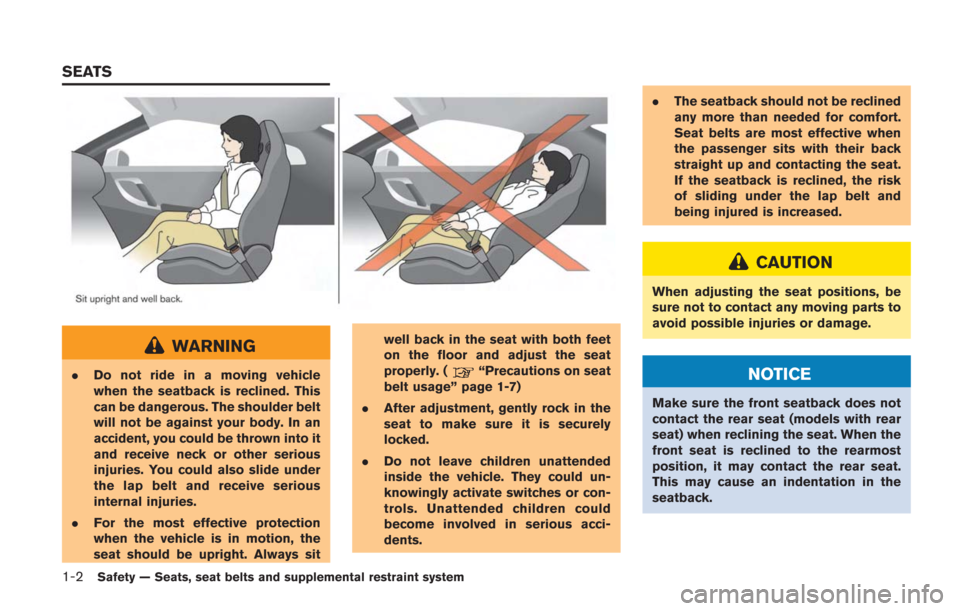
1-2Safety — Seats, seat belts and supplemental restraint system
WARNING
.Do not ride in a moving vehicle
when the seatback is reclined. This
can be dangerous. The shoulder belt
will not be against your body. In an
accident, you could be thrown into it
and receive neck or other serious
injuries. You could also slide under
the lap belt and receive serious
internal injuries.
. For the most effective protection
when the vehicle is in motion, the
seat should be upright. Always sit well back in the seat with both feet
on the floor and adjust the seat
properly. (“Precautions on seat
belt usage” page 1-7)
. After adjustment, gently rock in the
seat to make sure it is securely
locked.
. Do not leave children unattended
inside the vehicle. They could un-
knowingly activate switches or con-
trols. Unattended children could
become involved in serious acci-
dents. .
The seatback should not be reclined
any more than needed for comfort.
Seat belts are most effective when
the passenger sits with their back
straight up and contacting the seat.
If the seatback is reclined, the risk
of sliding under the lap belt and
being injured is increased.
CAUTION
When adjusting the seat positions, be
sure not to contact any moving parts to
avoid possible injuries or damage.
NOTICE
Make sure the front seatback does not
contact the rear seat (models with rear
seat) when reclining the seat. When the
front seat is reclined to the rearmost
position, it may contact the rear seat.
This may cause an indentation in the
seatback.
SEATS
Page 54 of 354
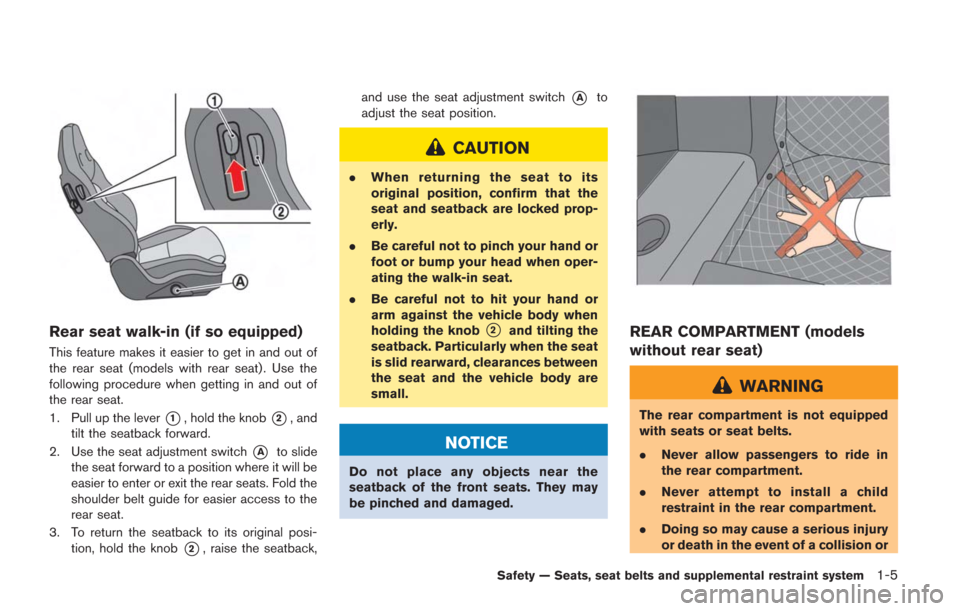
Rear seat walk-in (if so equipped)
This feature makes it easier to get in and out of
the rear seat (models with rear seat) . Use the
following procedure when getting in and out of
the rear seat.
1. Pull up the lever
*1, hold the knob*2, and
tilt the seatback forward.
2. Use the seat adjustment switch
*Ato slide
the seat forward to a position where it will be
easier to enter or exit the rear seats. Fold the
shoulder belt guide for easier access to the
rear seat.
3. To return the seatback to its original posi- tion, hold the knob
*2, raise the seatback, and use the seat adjustment switch
*Ato
adjust the seat position.
CAUTION
. When returning the seat to its
original position, confirm that the
seat and seatback are locked prop-
erly.
. Be careful not to pinch your hand or
foot or bump your head when oper-
ating the walk-in seat.
. Be careful not to hit your hand or
arm against the vehicle body when
holding the knob
*2and tilting the
seatback. Particularly when the seat
is slid rearward, clearances between
the seat and the vehicle body are
small.
NOTICE
Do not place any objects near the
seatback of the front seats. They may
be pinched and damaged.
REAR COMPARTMENT (models
without rear seat)
WARNING
The rear compartment is not equipped
with seats or seat belts.
. Never allow passengers to ride in
the rear compartment.
. Never attempt to install a child
restraint in the rear compartment.
. Doing so may cause a serious injury
or death in the event of a collision or
Safety — Seats, seat belts and supplemental restraint system1-5
Page 59 of 354
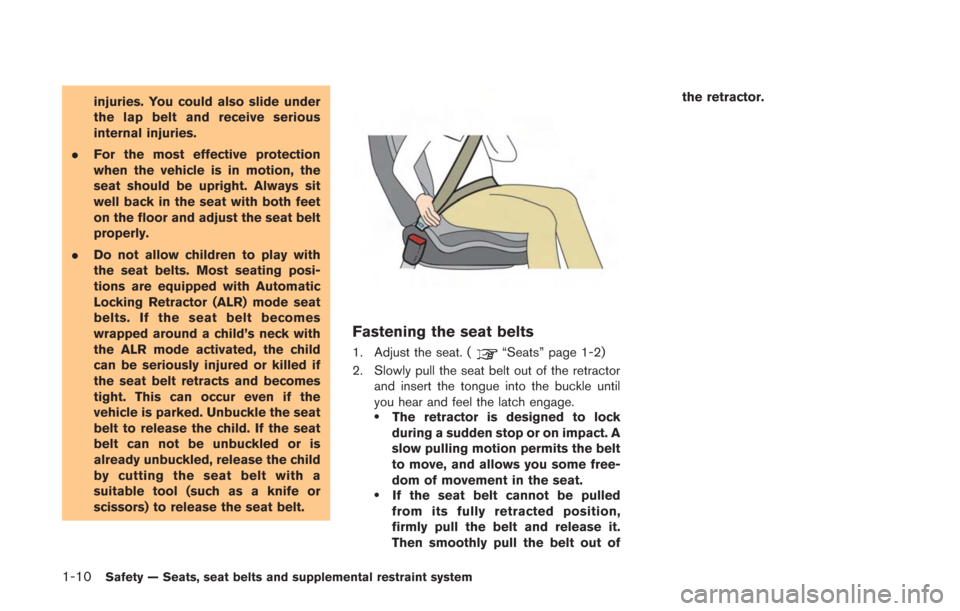
1-10Safety — Seats, seat belts and supplemental restraint system
injuries. You could also slide under
the lap belt and receive serious
internal injuries.
. For the most effective protection
when the vehicle is in motion, the
seat should be upright. Always sit
well back in the seat with both feet
on the floor and adjust the seat belt
properly.
. Do not allow children to play with
the seat belts. Most seating posi-
tions are equipped with Automatic
Locking Retractor (ALR) mode seat
belts. If the seat belt becomes
wrapped around a child’s neck with
the ALR mode activated, the child
can be seriously injured or killed if
the seat belt retracts and becomes
tight. This can occur even if the
vehicle is parked. Unbuckle the seat
belt to release the child. If the seat
belt can not be unbuckled or is
already unbuckled, release the child
by cutting the seat belt with a
suitable tool (such as a knife or
scissors) to release the seat belt.
Fastening the seat belts
1. Adjust the seat. (“Seats” page 1-2)
2. Slowly pull the seat belt out of the retractor and insert the tongue into the buckle until
you hear and feel the latch engage.
.The retractor is designed to lock
during a sudden stop or on impact. A
slow pulling motion permits the belt
to move, and allows you some free-
dom of movement in the seat.
.If the seat belt cannot be pulled
from its fully retracted position,
firmly pull the belt and release it.
Then smoothly pull the belt out of the retractor.
Page 60 of 354
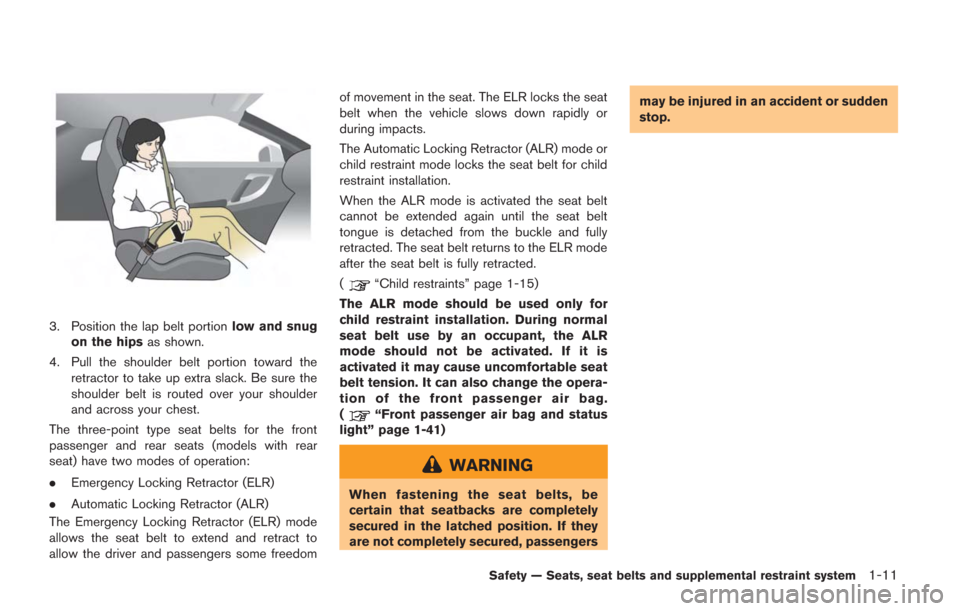
3. Position the lap belt portionlow and snug
on the hips as shown.
4. Pull the shoulder belt portion toward the retractor to take up extra slack. Be sure the
shoulder belt is routed over your shoulder
and across your chest.
The three-point type seat belts for the front
passenger and rear seats (models with rear
seat) have two modes of operation:
. Emergency Locking Retractor (ELR)
. Automatic Locking Retractor (ALR)
The Emergency Locking Retractor (ELR) mode
allows the seat belt to extend and retract to
allow the driver and passengers some freedom of movement in the seat. The ELR locks the seat
belt when the vehicle slows down rapidly or
during impacts.
The Automatic Locking Retractor (ALR) mode or
child restraint mode locks the seat belt for child
restraint installation.
When the ALR mode is activated the seat belt
cannot be extended again until the seat belt
tongue is detached from the buckle and fully
retracted. The seat belt returns to the ELR mode
after the seat belt is fully retracted.
(
“Child restraints” page 1-15)
The ALR mode should be used only for
child restraint installation. During normal
seat belt use by an occupant, the ALR
mode should not be activated. If it is
activated it may cause uncomfortable seat
belt tension. It can also change the opera-
tion of the front passenger air bag.
(
“Front passenger air bag and status
light” page 1-41)
WARNING
When fastening the seat belts, be
certain that seatbacks are completely
secured in the latched position. If they
are not completely secured, passengers may be injured in an accident or sudden
stop.
Safety — Seats, seat belts and supplemental restraint system1-11
Page 62 of 354
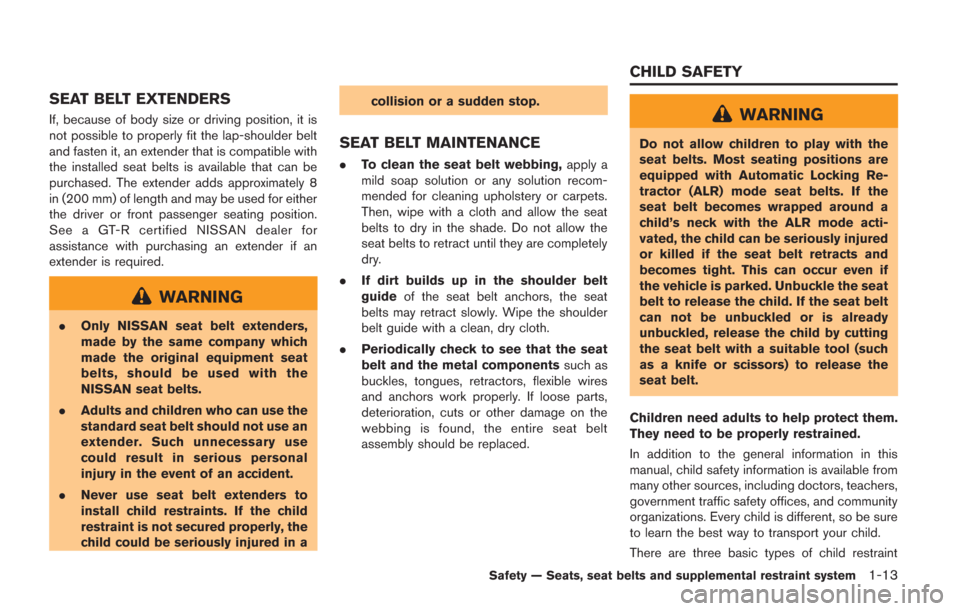
SEAT BELT EXTENDERS
If, because of body size or driving position, it is
not possible to properly fit the lap-shoulder belt
and fasten it, an extender that is compatible with
the installed seat belts is available that can be
purchased. The extender adds approximately 8
in (200 mm) of length and may be used for either
the driver or front passenger seating position.
See a GT-R certified NISSAN dealer for
assistance with purchasing an extender if an
extender is required.
WARNING
.Only NISSAN seat belt extenders,
made by the same company which
made the original equipment seat
belts, should be used with the
NISSAN seat belts.
. Adults and children who can use the
standard seat belt should not use an
extender. Such unnecessary use
could result in serious personal
injury in the event of an accident.
. Never use seat belt extenders to
install child restraints. If the child
restraint is not secured properly, the
child could be seriously injured in a collision or a sudden stop.
SEAT BELT MAINTENANCE
.
To clean the seat belt webbing, apply a
mild soap solution or any solution recom-
mended for cleaning upholstery or carpets.
Then, wipe with a cloth and allow the seat
belts to dry in the shade. Do not allow the
seat belts to retract until they are completely
dry.
. If dirt builds up in the shoulder belt
guide of the seat belt anchors, the seat
belts may retract slowly. Wipe the shoulder
belt guide with a clean, dry cloth.
. Periodically check to see that the seat
belt and the metal components such as
buckles, tongues, retractors, flexible wires
and anchors work properly. If loose parts,
deterioration, cuts or other damage on the
webbing is found, the entire seat belt
assembly should be replaced.
WARNING
Do not allow children to play with the
seat belts. Most seating positions are
equipped with Automatic Locking Re-
tractor (ALR) mode seat belts. If the
seat belt becomes wrapped around a
child’s neck with the ALR mode acti-
vated, the child can be seriously injured
or killed if the seat belt retracts and
becomes tight. This can occur even if
the vehicle is parked. Unbuckle the seat
belt to release the child. If the seat belt
can not be unbuckled or is already
unbuckled, release the child by cutting
the seat belt with a suitable tool (such
as a knife or scissors) to release the
seat belt.
Children need adults to help protect them.
They need to be properly restrained.
In addition to the general information in this
manual, child safety information is available from
many other sources, including doctors, teachers,
government traffic safety offices, and community
organizations. Every child is different, so be sure
to learn the best way to transport your child.
There are three basic types of child restraint
Safety — Seats, seat belts and supplemental restraint system1-13
CHILD SAFETY
Page 71 of 354
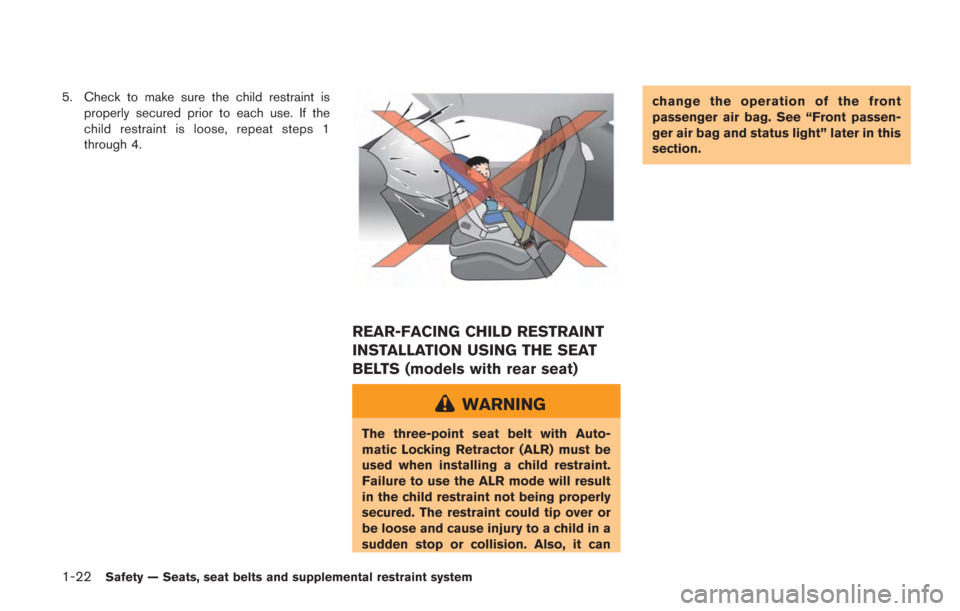
1-22Safety — Seats, seat belts and supplemental restraint system
5. Check to make sure the child restraint isproperly secured prior to each use. If the
child restraint is loose, repeat steps 1
through 4.
REAR-FACING CHILD RESTRAINT
INSTALLATION USING THE SEAT
BELTS (models with rear seat)
WARNING
The three-point seat belt with Auto-
matic Locking Retractor (ALR) must be
used when installing a child restraint.
Failure to use the ALR mode will result
in the child restraint not being properly
secured. The restraint could tip over or
be loose and cause injury to a child in a
sudden stop or collision. Also, it can change the operation of the front
passenger air bag. See “Front passen-
ger air bag and status light” later in this
section.
Page 72 of 354
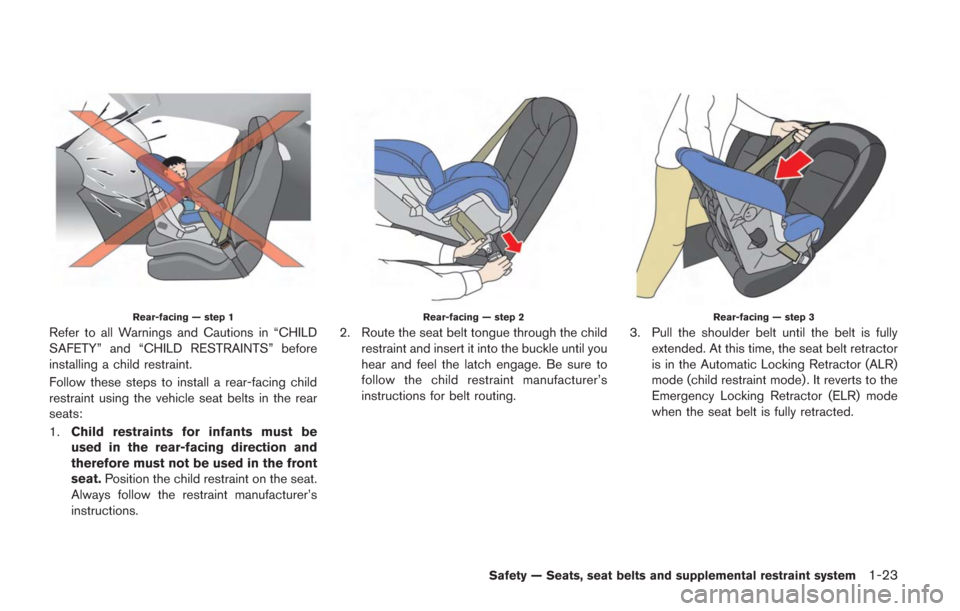
Rear-facing — step 1
Refer to all Warnings and Cautions in “CHILD
SAFETY” and “CHILD RESTRAINTS” before
installing a child restraint.
Follow these steps to install a rear-facing child
restraint using the vehicle seat belts in the rear
seats:
1.Child restraints for infants must be
used in the rear-facing direction and
therefore must not be used in the front
seat. Position the child restraint on the seat.
Always follow the restraint manufacturer’s
instructions.
Rear-facing — step 2
2. Route the seat belt tongue through the child restraint and insert it into the buckle until you
hear and feel the latch engage. Be sure to
follow the child restraint manufacturer’s
instructions for belt routing.
Rear-facing — step 3
3. Pull the shoulder belt until the belt is fullyextended. At this time, the seat belt retractor
is in the Automatic Locking Retractor (ALR)
mode (child restraint mode) . It reverts to the
Emergency Locking Retractor (ELR) mode
when the seat belt is fully retracted.
Safety — Seats, seat belts and supplemental restraint system1-23
Page 74 of 354
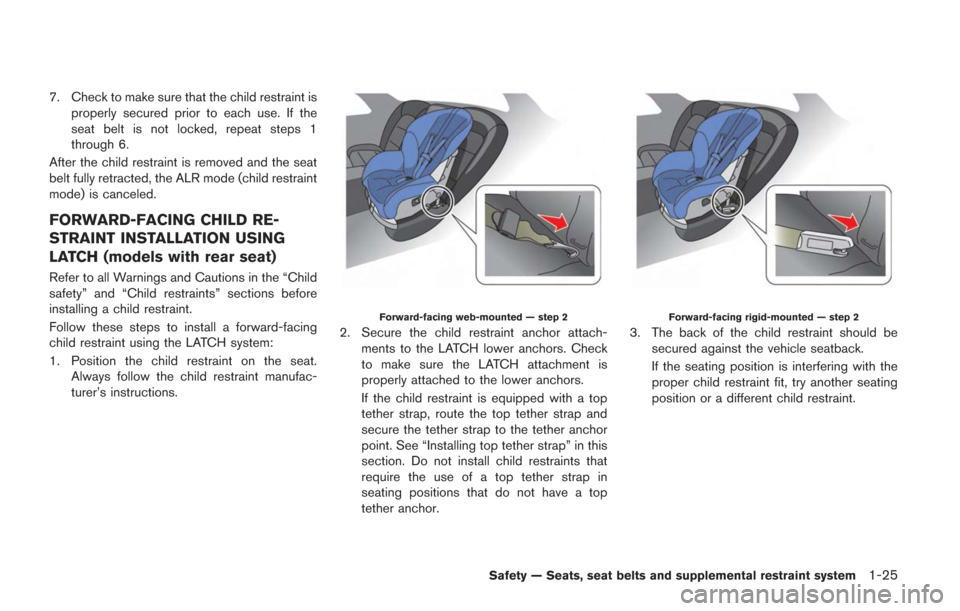
7. Check to make sure that the child restraint isproperly secured prior to each use. If the
seat belt is not locked, repeat steps 1
through 6.
After the child restraint is removed and the seat
belt fully retracted, the ALR mode (child restraint
mode) is canceled.
FORWARD-FACING CHILD RE-
STRAINT INSTALLATION USING
LATCH (models with rear seat)
Refer to all Warnings and Cautions in the “Child
safety” and “Child restraints” sections before
installing a child restraint.
Follow these steps to install a forward-facing
child restraint using the LATCH system:
1. Position the child restraint on the seat. Always follow the child restraint manufac-
turer’s instructions.
Forward-facing web-mounted — step 2
2. Secure the child restraint anchor attach-ments to the LATCH lower anchors. Check
to make sure the LATCH attachment is
properly attached to the lower anchors.
If the child restraint is equipped with a top
tether strap, route the top tether strap and
secure the tether strap to the tether anchor
point. See “Installing top tether strap” in this
section. Do not install child restraints that
require the use of a top tether strap in
seating positions that do not have a top
tether anchor.
Forward-facing rigid-mounted — step 2
3. The back of the child restraint should besecured against the vehicle seatback.
If the seating position is interfering with the
proper child restraint fit, try another seating
position or a different child restraint.
Safety — Seats, seat belts and supplemental restraint system1-25